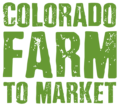Comminuted: Shall mean reduced in size by methods including chopping, flaking, grinding, or mincing. This includes fish or meat products that are reduced in size and restructured or reformulated such as gefilte fish, formed roast beef, gyros, ground beef, and sausage; and a mixture of two or more types of meat which have been reduced in size and combined, such as sausages made from two or more meats.
Fresh cut produce: Fresh produce that has been peeled and/or cut for the consumer is considered “processed food” as defined by the Federal Food, Drug, and Cosmetic Act (21 U.S.C. 321(gg)). Thus fresh-cut processors of fruits and vegetables are subject to the Colorado Good Manufacturing Practices (GMP) regulations. Colorado requires packaged, fresh cut produce and ready-to-eat salad mixes to be processed in an approved GMP-compliant facility or licensed retail food establishment.
Gelatin: A “product obtained from partial hydrolysis of collagen derived from natural sources such as skin, connective tissue, and bones of animals.” It is an easily digestible protein that contains all the essential amino acids except tryptophan. Gelatin is NOT a chemical or chemically modified substance. The raw materials used in the production of gelatin are from healthy animals and include cattle bone, cattle hides and fresh, frozen pigskins.
Non-Potentially Hazardous Food: A food that does not require temperature control because it does not support the growth of disease causing organisms. Examples include: acidic foods with a pH of 4.6 or less (such as ketchup), dry foods with a water activity of 0.85 or less (such as jerky, cookies or fruit pies), commercially canned foods, and frozen foods.
Pectin: A substance necessary for gel formation, occurs naturally in most fruits. It is concentrated in the skins and cores of various fruits. This is why many recipes include the skins and cores in preparing fruit for juice or pulp. The amount of pectin varies with the kind of fruit and degree of ripeness. Under ripe fruit has a higher pectin content. As fruit ripens, the pectin is changed to a nongel-forming substance.
Potentially Hazardous Food: A food that requires temperature control (41° or less, or 135° or above) because it is capable of supporting the growth of disease causing organisms. Examples include meats, cheeses, and cooked vegetables.
Prepared foods: Foods that are typically produced for immediate consumption. “Preparing” is any act other than washing with water and may include peeling, cutting, dicing, or cooking of a food item. Peeling apples, washing and chopping lettuce, cutting carrots, and making cole slaw from cabbage are all examples of preparation. Vendors that are preparing, packaging, or serving food must be licensed as a retail food establishment (e.g. chili roasters require a retail food establishment license).
Defined in three ways:
1. The food is heated (or previously heated) by the seller. May include foods such as pizza, popcorn, hot chocolate/coffee, hot dogs, or nachos.
2. Two or more foods items are mixed or combined by the seller or foods that need additional preparation. May include foods such as sandwiches, salads, cut fruit or vegetable trays.
3. Food sold with eating utensils. If a container or utensils is required to hold the food or the food is prepared food for immediate consumption, such as hot soup.
Raw agricultural products: This describes food in its raw or natural state, and includes shell eggs, raw meat, and fruits and vegetables in their whole, unpeeled or unprocessed form. Minimal processing at the farm, such as rinsing off soil and debris, is not considered processing and therefore fresh uncut produce is still characterized as a raw agricultural commodity.
Ready-to-eat food: Food that is edible without further washing, cooking, or additional preparation and that is reasonably expected to be consumed in that form.
Retail food establishment (RFE): A retail operation that stores, prepares or packages food for human consumption. An RFE may be located in a fixed structure with water and sewer service, a mobile unit or a push cart.
Value added products: Raw agricultural products that have been modified or enhanced to have a higher market value and/or a longer shelf life. Some examples include fruits made into pies or jams, meats made into jerky, and tomatoes and peppers made into salsa. Raw agricultural commodities that are altered from the whole fruit or vegetable state by slicing, dicing, cutting, chopping, cooking, mixing, grinding, smoking, drying, packaging, canning or other procedures that alter the food from its original state, are subject to Colorado Wholesale Food Regulations. All processed foods sold at Farmer’s Markets must be manufactured in an approved facility which has been inspected by the health department for Good Manufacturing Practices.
